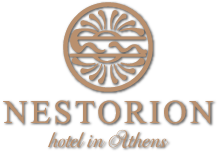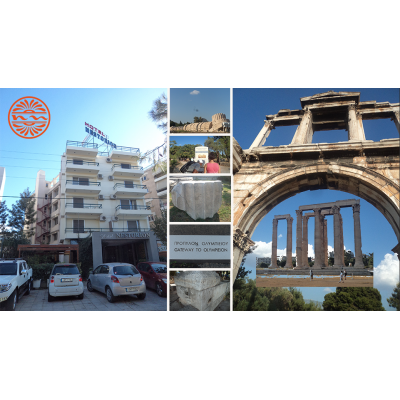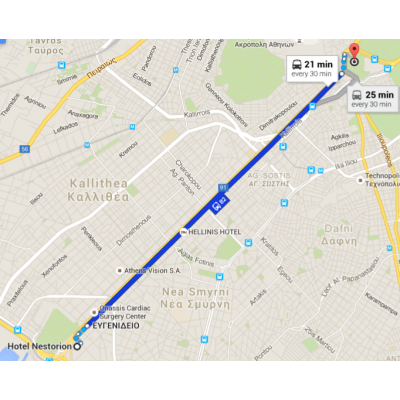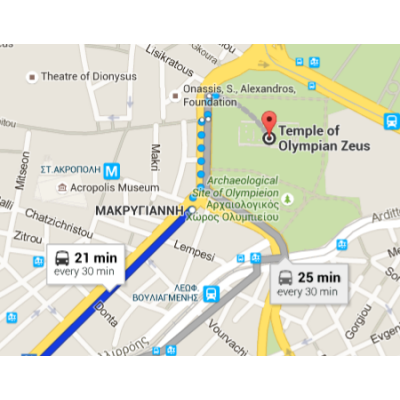The colossus of Athens
the budget hotel in athens
THE OLYMPIEION: The ..colossus of Athens
The Olympeion includes the sanctuary (temple) of the Olympeian Zeus, Roman baths, classical houses as well as a section of the ancient citys fortification wal. According to the Geographer Pausanias, the temple of Olympian Zeus was founded by Deukalionas a mythical ancestor of the Greeks. In the age of tyranny, circa 515 BC, Peisistratos the younger grandson of the tyrant Peisistratos, attempted to replace the old temple with a new, more impressive temple. The tyranny, however, was abolished and construction work was terminated. The construction of the new temple was latter assigned to the Roman architect Decimus Cossutius by the king of Syria Antiochus IV, Epiphanes.
Antiochus died in 163 BC and the construction of the temple was once again abandoned. The structure did not have a roof and pediment. The construction of the temple which ranks among the biggest in the antiquity, was completed in 131 AD by the Roman Emperor Hadrian. It is of Corinthian order (110m in length and approximately 44m in width), three rows of eight columns at the narrow sides and two rows of twenty columns at its long sides. Inside the temple there was a gold and ivory statue of Zeus which does not exist today.
ILISSOS VALEY
The surviving section of the Ilissos river valley (right behind the temple of Olympian Zeus) is wort a visit. In antiquity the Ilissos river was known as the sacred river of the Muses. Scattered remains of the ancient sanctuaries are located in the valley. You will find nearby the rock of the Kalliroi spring which was famous in antiquity - and the church of Agia Fotini, which was built in 1872 at the side of an ancient temple, on the foundation of the sacred sanctuary of Ekati. You will find nearby, the preserved monuments of the classical, Roman, and Byzantine age, among others, (the Temple of Apollo Delphinios, the Temple of Cronos and Rhea, a Byzantine quarter with workshops, and Leonidis Church).
HADRIANS ARCH
Following the construction of the temple of Zeus, the Athenians, in 131 AD, in honor of Emperor Hadrian, built an arch on the northwestern perimeter of the temple. The monument is 18m tall and 13m wide while the arch, built of Pentelic marble, bears two inscriptions on the architrave over the arch. One inscription, facing the Acropolis and the old town and the old town (facing west) says: "This is Athens the city of Theseus". The other inscription, facing the sanctuary and an extension of Athens constructed by Hadrian, (facing east) says: "This is the city of Hadrian , not Theseus".
TOURIST TIPS:
1. Hotel NESTORION propose to visit the above historical monuments. These monuments belong to the Roman era. To get there you take the bus B2 (21min, 5,6 km) from the Planetarium stop and get off at the stop Makrygiannis. The monument is far 8 minutes, see map. Alternative bus is 550 and bus stop Sygrou Fix.
2. Another way to visit the monument is the bus Hop Hop off which passes from Planetarium stop every half hour 00.35 / 00.05. You get off at the BUS STOP 5 / Temple of Zeus and Arch of Hadrian. You will visit the monument as long as you need and will regain the Hopon Hopoff (http://www.citysightseeing.gr). The next stop is 6 and 9 The Greek Parliament and the National Gardens.
3. Google map: https://goo.gl/maps/SvCyI
We wish you a nice tour
4.Βιβλιογραφία: Εκδόσεις Δομή και free copy μπροσούρας Υπουργείου Τουρισμού
The Olympeion includes the sanctuary (temple) of the Olympeian Zeus, Roman baths, classical houses as well as a section of the ancient citys fortification wal. According to the Geographer Pausanias, the temple of Olympian Zeus was founded by Deukalionas a mythical ancestor of the Greeks. In the age of tyranny, circa 515 BC, Peisistratos the younger grandson of the tyrant Peisistratos, attempted to replace the old temple with a new, more impressive temple. The tyranny, however, was abolished and construction work was terminated. The construction of the new temple was latter assigned to the Roman architect Decimus Cossutius by the king of Syria Antiochus IV, Epiphanes.
Antiochus died in 163 BC and the construction of the temple was once again abandoned. The structure did not have a roof and pediment. The construction of the temple which ranks among the biggest in the antiquity, was completed in 131 AD by the Roman Emperor Hadrian. It is of Corinthian order (110m in length and approximately 44m in width), three rows of eight columns at the narrow sides and two rows of twenty columns at its long sides. Inside the temple there was a gold and ivory statue of Zeus which does not exist today.
ILISSOS VALEY
The surviving section of the Ilissos river valley (right behind the temple of Olympian Zeus) is wort a visit. In antiquity the Ilissos river was known as the sacred river of the Muses. Scattered remains of the ancient sanctuaries are located in the valley. You will find nearby the rock of the Kalliroi spring which was famous in antiquity - and the church of Agia Fotini, which was built in 1872 at the side of an ancient temple, on the foundation of the sacred sanctuary of Ekati. You will find nearby, the preserved monuments of the classical, Roman, and Byzantine age, among others, (the Temple of Apollo Delphinios, the Temple of Cronos and Rhea, a Byzantine quarter with workshops, and Leonidis Church).
HADRIANS ARCH
Following the construction of the temple of Zeus, the Athenians, in 131 AD, in honor of Emperor Hadrian, built an arch on the northwestern perimeter of the temple. The monument is 18m tall and 13m wide while the arch, built of Pentelic marble, bears two inscriptions on the architrave over the arch. One inscription, facing the Acropolis and the old town and the old town (facing west) says: "This is Athens the city of Theseus". The other inscription, facing the sanctuary and an extension of Athens constructed by Hadrian, (facing east) says: "This is the city of Hadrian , not Theseus".
TOURIST TIPS:
1. Hotel NESTORION propose to visit the above historical monuments. These monuments belong to the Roman era. To get there you take the bus B2 (21min, 5,6 km) from the Planetarium stop and get off at the stop Makrygiannis. The monument is far 8 minutes, see map. Alternative bus is 550 and bus stop Sygrou Fix.
2. Another way to visit the monument is the bus Hop Hop off which passes from Planetarium stop every half hour 00.35 / 00.05. You get off at the BUS STOP 5 / Temple of Zeus and Arch of Hadrian. You will visit the monument as long as you need and will regain the Hopon Hopoff (http://www.citysightseeing.gr). The next stop is 6 and 9 The Greek Parliament and the National Gardens.
3. Google map: https://goo.gl/maps/SvCyI
We wish you a nice tour
4.Βιβλιογραφία: Εκδόσεις Δομή και free copy μπροσούρας Υπουργείου Τουρισμού





